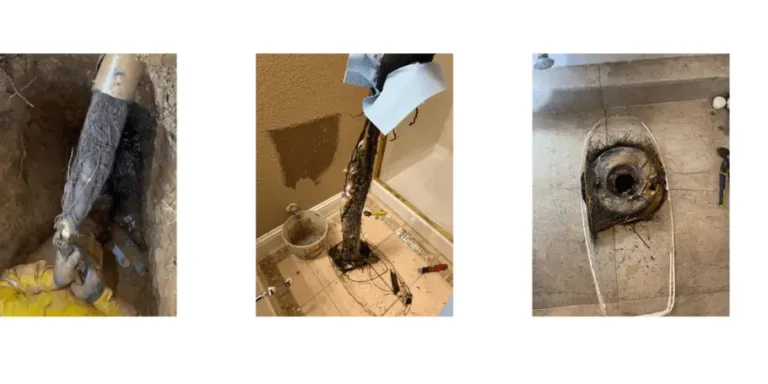FIVE-STAR TEAM WARRANTY &
SAME-DAY SERVICE
Tree Roots in Sewer Line: Understanding Causes and Solutions
Tree roots can infiltrate sewer systems, causing blockages and other issues. Recognizing potential causes and solutions is crucial for proper maintenance. Homeowners should be proactive in identifying problems and implementing preventive measures.
What Leads to Roots Entering a Sewer Pipe?
Tree roots naturally seek out moisture to support their growth and nutrient distribution. A minor fracture or malalignment in a sewer line can attract roots, as they are drawn to any moisture escaping from the pipe. Once inside, these roots find a rich source of water, allowing them to proliferate. This growth can cause significant damage, potentially shattering the pipe and obstructing proper drainage.

Indicators of Roots in a Sewer Pipe:
- Saturated Areas: Waterlogged sections in the yard may signal broken pipes from root intrusion.
- Unpleasant Odors: A foul sewer smell around the property can indicate root issues.
- Gurgling Sounds: Toilets and drains may gurgle even after using cleaning solutions.
- Clogged Pipes: Slow draining or frequent backups are common signs of root interference.
- Sinkholes: Areas of ground collapse may result from water erosion due to root activity.
Awareness of these symptoms can help identify potential problems with tree roots in sewer lines.
Where Is the Sewer Line?
The primary function of the sewer line is to connect the main drain line to the municipal sewer main. Generally, this line runs directly from the house straight through the front yard. In certain homes, especially those with alleys nearby, the sewer line may direct waste toward that alley instead.
To pinpoint the direction of the sewer line, one effective method is to go into the basement or crawl space and observe where the main drain line connects to the sewer. Typically, the sewer line will run straight out, without any turns, leading toward the sewer main.
For mapping the sewer line more accurately, individuals can contact 8-1-1, or Dig-Safe. These professionals provide services to locate sewer lines, water lines, gas lines, and other underground utilities on the property.
Caution: Tree roots can extend up to 100 feet away from a tree. Therefore, any trees in the vicinity of a property may be contributing factors to sewer line issues.
5 Methods to Remove Tree Roots in a Sewer Line
1. Utilize Rock Salt
Rock salt can effectively extract moisture from tree roots, leading to their eventual demise. Available at most home improvement retailers, its application is straightforward. To use rock salt, a user should pour half a pound into the toilet and flush until it is fully cleared. This process should be repeated, allowing a total of two pounds of rock salt to enter the drain. Following this, the system should rest for 12 hours without any additional flushing.
2. Apply a Foaming Root Killer
Specific products are designed to target and eliminate tree roots within sewer lines without harming the tree itself. These foaming root killers activate upon contact with water, moving through the pipes to destroy roots. The procedure for using a foaming root killer typically involves the following steps:
- Pour the appropriate amount of the product into the toilet.
- Immediately flush to ensure the foam travels into the sewer line (some products may necessitate multiple flushes).
- Allow the sewer system to sit undisturbed for 10 to 12 hours.
- Repeat this for up to five consecutive days.
3. Use Copper Sulfate
Copper sulfate serves as another viable option for eradicating tree roots from sewer lines. It can be found at hardware and home improvement stores, though it might require special ordering due to its hazardous nature. To apply copper sulfate, a user should pour half a cup into the toilet and flush several times, allowing the system to remain untouched for approximately six hours. It is important to ensure that children and pets are kept away during this time due to safety concerns.
4. Examine, Extract, and Fix the Damage
When tree root problems are apparent, such as in soggy areas of the yard, determined individuals may choose to excavate to access the pipes and remove both the roots and damaged sections themselves. It’s essential to note that roots often cling tightly to pipe walls and other debris, making manual removal quite challenging. While many plumbers use industrial sewer snakes for effective removal, these tools may pose risks for those without professional experience. If successfully extracted, repairing the pipe is crucial. This project can be daunting for an inexperienced DIYer, but it can be accomplished with dedication and careful effort.
5. Consult a Professional
If tree roots resist removal using treatments such as root killers, rock salt, or copper sulfate, and do-it-yourself solutions prove insufficient, engaging a professional plumber is advisable. A skilled plumber can accurately identify damage, remove any compromised pipes, clear the system of roots, and repair the sewer line efficiently. Though this solution may incur higher costs, it offers a more lasting resolution to the issue.
Strategies to Prevent Tree Roots in Sewer Lines
Key Points
To prevent tree roots from invading sewer lines, several effective strategies can be employed:
- Periodic Application of Root Killer: A tree root killer that foams can be applied every two months. A recommended dose is approximately half a pound, following the guidance provided by the manufacturer.
- Pipe Upgrades: Replacing outdated or damaged sewer pipes with modern materials can be beneficial. While the initial investment for plumbing services may appear substantial, proactive replacements can lead to long-term savings by avoiding more extensive repairs in the future.
Careful Planting Practices: When planting trees, it’s essential to consider the proximity to sewer lines. Ideally, trees should not be planted directly on or within 30 feet of a new sewer line. For older lines, it’s advisable to maintain a distance of at least 100 feet from large trees.
Post views: 792
Latest posts

How Long Do Water Heaters Last? Typical Lifespan by Type (Homeowner’s Guide)
Your water heater works quietly behind the scenes every single day until one day it doesn’t. One of the most common...

Electrical Panel Upgrade California: Costs, Safety & When You Need One
An electrical panel upgrade in California is one of the most important safety and performance improvements a...


If you still have questions or need advice, please leave a request and we will contact you as soon as possible
Need a plumber and got no clue where to start?
(408) 539-6936Facing a plumbing issue? Get a FREE in-person estimate and quick solutions from our skilled technicians, ensuring your home runs smoothly again!
